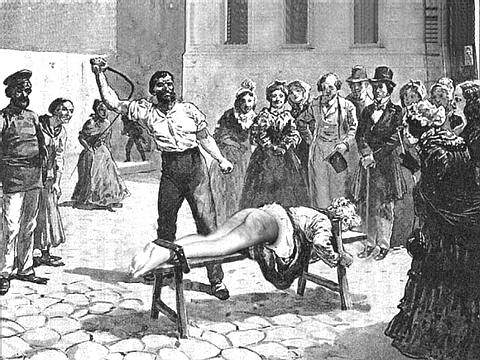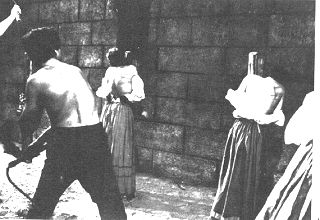 |
 |
Ancient Greece and Rome, where flogging was used for punishing criminals,
were cultures which applauded the physical prowess of men, valued military
might and relied on slaves to do the work for satisfying everyday needs.
In the Roman Empire, the ferula
 |
 |

Public whipping

Punishment with the "Knut" in Russia |
The whip and the cane have been used by slave-drivers and
the owners of labour to extract more work from their subjects, since time
immemorial. Slaves were being beaten for their increasing incapacity, and
were replaced by a seemingly endless supply of fresh labour.
Biblical references to the use of corporal punishment are widespread. Calmet's Dictionary of the Bible apparently records 168 faults subject to corporal punishment. In the New Testament, Christ used a scourge, made of small cords bound together, to drive the money-lenders out of the temple. Corporal Punishment continued to play a prominent part in relegious persecution. The Society of Friends, or Quakers, were subjected to widespread religious persecution, from their foundation in the mid-seventeenth century, in many parts of Biritain and, subsequently in the USA. Whipping was a common punishment employed to try to enforce their conformity. In the sixteenth to the eighteenth centuries, men and women were whipped for many offences all over the world. |
| The late eighteenth century saw a general reaction against
corporal punishment in the most states in Europe. The corporal punishment
was abolished in this time with one exception: birching of
young offenders and flogging adult offenders with the cat-o'nile-tails
were still a part of the penal code in Britain until its repeal in 1948.
The last flogging of an offender in the USA was in 1952.
|

Flogging of prostitutes |
 |
The Manual of Correctional Standards (1954)
of the American Prison Association only disapproved of 'corporal
punishments of the humiliating type' and reported that in several
institutions 'women as men are flogged with a heavy leather strap
as punishment for both minor and major infractions of the rules. The punishment
is usually inflicted by a male employee'. Prison flogging in England
and Wales was abolished in 1967.
The effectiveness of corporal punishment has been questioned by criminologists and educators, but it is still widely used in the present days. Flogging, for instance, was not banned in Singapore, and is also used in some countries, expecially in those whose legal system based on Islamic Law. And within British and American prisons flogging and beatings are still used, unofficially, to maintain order.
|